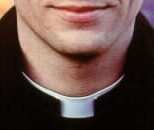Selecting a new pope: The second phase--the scrutiny (part 8)
The ballot paper is rectangular and must have in the upper half the words Eligo in Summum Pontificem. On the lower half there must be space for writing the name of the person the cardinal wishes to elect. Each cardinal must write his selection legibly by hand in such a way that no one can identify to whom the handwriting belongs. He only writes one name down; if two names are found listed in a ballot, that ballot will be considered void. Then the cardinals fold their ballots twice.
Each cardinal, having completed and folded his ballot, carries it to the altar of the Sistine Chapel, holding it up so all can see. Upon reaching the altar the candidate says aloud the oath, "I call as my witness Christ the Lord who will be my judge, that my vote is given to the one who before God I think should be elected." He then places his ballot on a plate covering a receptacle, usually an urn. He takes the plate and uses it to drop his ballot onto this receptacle.
After all the ballots have been placed in the receptacle by each of the cardinals, one of the scrutineers shakes it several times and then proceeds to count them. He picks the ballots out of the urn in full view of the cardinals, places them in another empty receptacle. If the number of ballots do not match the number of cardinals present, the ballots are all burned and a second vote taken immediately. If the numbers do match, the ballots are then individually opened.
The first scrutineer unfolds the ballot and notes the name written. He hands it to the second scrutineer who also notes the name down and hands it to a third scrutineer who reads the name aloud so that all the cardinals can hear and, if they so choose, so that the cardinals may write this name in their notes.
When all the ballots have been opened, the scrutineers add up all the votes and write them down. Then, the third scrutineer pierces each ballot with a needle through the word Eligio and places it on a thread so that the ballots can be easily preserved. After the names have been read and the ends of the thread tied in a knot, the ballots are then placed in a receptacle or on one side of the table used by the scrutineers.
If no one obtained two thirds of the votes, a pope has not been elected. If however it turns out that someone has received two thirds, a canonically valid election has occurred. The revisers then review the ballots.
[Coming up in part 9: the post-scrutiny]
Each cardinal, having completed and folded his ballot, carries it to the altar of the Sistine Chapel, holding it up so all can see. Upon reaching the altar the candidate says aloud the oath, "I call as my witness Christ the Lord who will be my judge, that my vote is given to the one who before God I think should be elected." He then places his ballot on a plate covering a receptacle, usually an urn. He takes the plate and uses it to drop his ballot onto this receptacle.
After all the ballots have been placed in the receptacle by each of the cardinals, one of the scrutineers shakes it several times and then proceeds to count them. He picks the ballots out of the urn in full view of the cardinals, places them in another empty receptacle. If the number of ballots do not match the number of cardinals present, the ballots are all burned and a second vote taken immediately. If the numbers do match, the ballots are then individually opened.
The first scrutineer unfolds the ballot and notes the name written. He hands it to the second scrutineer who also notes the name down and hands it to a third scrutineer who reads the name aloud so that all the cardinals can hear and, if they so choose, so that the cardinals may write this name in their notes.
When all the ballots have been opened, the scrutineers add up all the votes and write them down. Then, the third scrutineer pierces each ballot with a needle through the word Eligio and places it on a thread so that the ballots can be easily preserved. After the names have been read and the ends of the thread tied in a knot, the ballots are then placed in a receptacle or on one side of the table used by the scrutineers.
If no one obtained two thirds of the votes, a pope has not been elected. If however it turns out that someone has received two thirds, a canonically valid election has occurred. The revisers then review the ballots.
[Coming up in part 9: the post-scrutiny]




<< Home